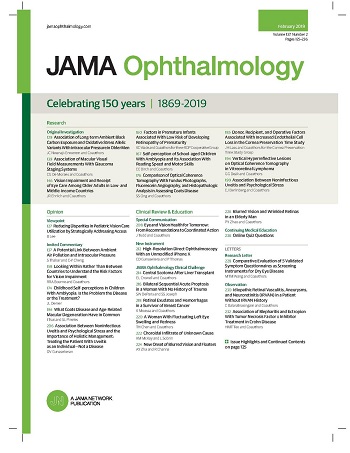新诊断青光眼患者的护理质量。
IF 9.2
1区 医学
Q1 OPHTHALMOLOGY
引用次数: 0
摘要
各个社区的青光眼相关视力损害和失明的发生率仍然相对较高。确定对青光眼预后的潜在非医学影响可能导致改善青光眼护理的策略。目的探讨非医学变量与新诊断原发性开角型青光眼(POAG)患者青光眼护理质量的关系。设计、环境和参与者本回顾性队列研究纳入了2010年1月至2022年12月在视力结局研究合作(SOURCE)联盟卫生系统接受治疗的1466例新诊断的POAG患者。数据分析时间为2024年3月至2025年6月。各种非医学变量,包括自我报告的种族和民族、居住地的城市化程度、患者居住社区的富裕程度以及家中是否有儿童。主要结局和测量主要结局是在初始POAG诊断后12至18个月时眼压(IOP)降低15%或更高的几率和随访损失(LTFU)的几率。结果患者平均(SD)年龄70(12)岁;1466例患者中,女性793例(54%)。根据自我报告的种族和民族,39例(3%)为亚裔美国人,469例(32%)为黑人,95例(7%)为拉丁裔,831例(57%)为白人。在1030例(70%)患者中,在初始POAG诊断后的12 - 18个月内进行了1次或1次以上的随访评估,其中783例(76%)患者1只或多只眼睛的IOP降低了15%或更高。与高四分位数的患者相比,最低财富四分位数的患者实现15%或更高IOP降低的几率低5至9倍;最富裕患者四分位数发生LTFU的几率比最不富裕组低61%(优势比[OR], 0.39; 95% CI, 0.18-0.84; P = 0.02)。农村社区的患者(OR, 5.54; 95% CI, 1.13-27.08)比城市居民更有可能经历LTFU。家中有儿童的患者相比家中没有儿童的患者,IOP平均降低了4毫米汞柱(95% CI, 0.99-7.13) (P = 0.01)。结论和相关性在这项队列研究中,处于最低财富四分位数的新诊断POAG患者实现美国国家质量论坛推荐的IOP百分比降低的可能性大大降低,并且与财富水平较高的患者相比,更有可能经历LTFU。这些发现支持这样一个前提,即临床医生在做出管理决策时应了解患者的财务状况,并强调临床医生和付款人需要找到方法,确保患者能够获得降低内压的干预措施,并按照既定指南接受后续护理。本文章由计算机程序翻译,如有差异,请以英文原文为准。
Quality of Care in Patients With Newly Diagnosed Glaucoma.
Importance
Various communities continue to experience relatively high rates of glaucoma-related visual impairment and blindness. Identifying potential nonmedical influences on glaucoma outcomes may lead to strategies to improve glaucoma care.
Objective
To assess possible associations between nonmedical variables and quality of glaucoma care among patients with newly diagnosed primary open-angle glaucoma (POAG).
Design, Setting, and Participants
This retrospective cohort study included 1466 patients with newly diagnosed POAG receiving care at health systems in the Sight Outcomes Research Collaborative (SOURCE) Consortium from January 2010 to December 2022. Data analysis was completed from March 2024 to June 2025.
Exposures
Various nonmedical variables, including self-reported race and ethnicity, urbanicity of residence, affluence of patients' residential community, and presence of children in the household.
Main Outcomes and Measures
The primary outcomes were odds of 15% or greater intraocular pressure (IOP) reduction at 12 to 18 months following initial POAG diagnosis and odds of loss to follow-up (LTFU).
Results
Mean (SD) age of patients was 70 (12) years; among 1466 patients, 793 (54%) were female. By self-reported race and ethnicity, 39 patients (3%) were Asian American, 469 patients (32%) were Black, 95 (7%) were Latinx, and 831 (57%) were White. Among 1030 patients (70%) with 1 or more follow-up evaluations within 12 to 18 months following initial POAG diagnosis, 783 (76%) achieved 15% or higher IOP reduction in 1 or more eyes. Patients in the lowest wealth quartile had 5- to 9-fold lower odds of achieving 15% or greater IOP decrease compared with patients in higher quartiles; the odds of LTFU were 61% lower in the wealthiest patient quartile than in the least-wealthy group (odds ratio [OR], 0.39; 95% CI, 0.18-0.84; P = .02). Patients in rural communities (OR, 5.54; 95% CI, 1.13-27.08) were more likely than urban residents to experience LTFU. Patients with children in the household experienced, on average, a 4-mm Hg (95% CI, 0.99-7.13) greater IOP reduction compared with those without children in the household (P = .01).
Conclusions and Relevance
In this cohort study, patients with newly diagnosed POAG in the lowest wealth quartile were substantially less likely to achieve the US National Quality Forum's recommended IOP percentage reduction and considerably more likely to experience LTFU than those with higher wealth levels. These findings support the premise that clinicians should understand financial circumstances of patients when making management decisions and reinforce the need for clinicians and payors to find ways to ensure that patients can access IOP-lowering interventions and receive follow-up care in accordance with established guidelines.
求助全文
通过发布文献求助,成功后即可免费获取论文全文。
去求助
来源期刊

JAMA ophthalmology
OPHTHALMOLOGY-
CiteScore
13.20
自引率
3.70%
发文量
340
期刊介绍:
JAMA Ophthalmology, with a rich history of continuous publication since 1869, stands as a distinguished international, peer-reviewed journal dedicated to ophthalmology and visual science. In 2019, the journal proudly commemorated 150 years of uninterrupted service to the field. As a member of the esteemed JAMA Network, a consortium renowned for its peer-reviewed general medical and specialty publications, JAMA Ophthalmology upholds the highest standards of excellence in disseminating cutting-edge research and insights. Join us in celebrating our legacy and advancing the frontiers of ophthalmology and visual science.
 求助内容:
求助内容: 应助结果提醒方式:
应助结果提醒方式:


